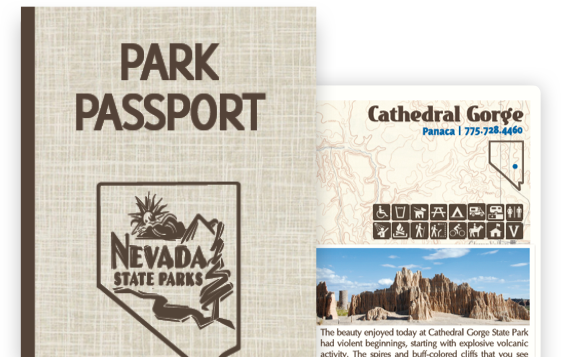History of Dayton State Park
Once a traditional Paiute meeting place, Dayton was used as a base camp for fishing on the Carson River and as a winter camp, sheltered from the snows of the nearby Sierra. The discovery of silver and gold changed that forever. In 1849, Abner Blackburn, during a stopover on his way to the California gold fields, was the first to find gold. Legend has it he used a hunting knife and a frying pan to prospect. It was not a rich strike, however, and as California beckoned, Abner and his friends moved on.
In 1849, Spafford Hall built a log trading post to serve prospectors and emigrants, and the area became known as Halls Station. Over the next few years the name changed several times and finally, in 1861, the town was named Dayton after town surveyor and future Surveyor General John Day.
Dayton was the Lyon County seat from 1861 until 1909, when one of the frequent and often suspicious fires burned the courthouse. At that point, Yerington won the battle to become the county seat.
It was the silver discoveries that created the need for stamp mills to crush the rock and release the metal for use. There was water available in the valley and in 1861 the first ore crushing stamp mill was built in Dayton. Eventually there were 21 quartz mills along the Carson River. The Rock Point Mill, located in the Park on the west side of the highway, was one of the earliest large mills in Nevada built to crush ore from the Comstock mines. The mill brought workers and merchants from across the Nevada Territory, turning Dayton into a bustling mining town.
In the mid 1850s, camels were tested by Lt. Edward Beale of the U.S. Army for use in caravan operations in the southwest. The experiment was unsuccessful. The camels were auctioned off and brought to Dayton to haul wood and salt to the mills and mines of the Comstock. The Leslie Hay Barn on Pike Street corralled the camels and they were used for the next 10 years. They were later abandoned to fend for themselves. Few were seen after the 1880s.
Dayton was a Pony Express stop between July 1, 1861, and November 20, 1861, and also served as a stage stop and depot for the newly completed railroad.
Disastrous fires in 1866, and again in 1870, wiped out most of the town, and the population dwindled. Construction of the Sutro Tunnel in the late 1870s revived Dayton's population to some extent, but the fires took a toll. By 1900 the population had dropped to a mere 500 residents due to the decline in the mining industry.
The mill, too, was destroyed by fire, first in 1882 and again in 1909, and floods also caused damage. Although the mill was rebuilt, demand lessened and it was dismantled and moved to Silver City in the 1920s.
Huge quantities of wood were needed to support the mining activities in Virginia City and surrounding areas. Dayton was known as the "Cordwood Capitol" of Nevada and by around 1870, all the wood from the valley was cut. Then, from the 1920s to 1954, the mill site was used as the local dump. In 1954 the property was deeded to the Nevada Department of Transportation, and in 1977 the Nevada Legislature officially transferred the land to Nevada State Parks, establishing Dayton State Park. Construction began early in 1979 and the park was opened to the public in the fall of that year.
The Carson River flood of 1997 substantially changed the flow of the river, which is now considerably more to the east than before the flood. The park now serves as a site for year-round camping, picnicking, nature study and events in the park's group area.



